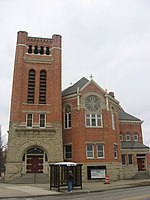Toledo School for the Arts

Toledo School for the Arts is a public charter school in downtown Toledo, Ohio founded by former director Martin Porter. It was first sponsored by the Toledo Board of Education. In 2008 the school was chartered by Bowling Green State University. TSA serves over 700 students from any school district in Ohio in Junior Division (6th, 7th and 8th grades), and Senior Division (9th, 10th, 11th and 12th grades). TSA's college preparatory curriculum integrates the visual, language, and performing arts. In addition to core academic subjects, classes are offered in dance, music, theatre, English language, humanities, and visual arts and include training and career development for students interested in pursuing professions in the arts. TSA students have been accepted to many of the nation's best colleges and universities.
Excerpt from the Wikipedia article Toledo School for the Arts (License: CC BY-SA 3.0, Authors, Images).Toledo School for the Arts
14th Street, Toledo
Geographical coordinates (GPS) Address External links Nearby Places Show on map
Geographical coordinates (GPS)
| Latitude | Longitude |
|---|---|
| N 41.656388888889 ° | E -83.543611111111 ° |
Address
Toledo School For the Arts
14th Street 333
43624 Toledo
Ohio, United States
Open on Google Maps









